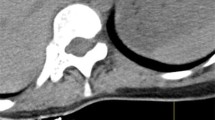Abstract
To our knowledge, the assessment of dural sac diameters in patients with adolescent idiopathic scoliosis (AIS) is not reported in the literature. The aim of this study was to find out if, dural ectasia occurs more frequently among patients with AIS, to define cut-off values for dural sac ratio and test the validity of such values. A total of 126 spine MRIs (79 patients with AIS and 47 control subjects) were included in this retrospective analysis (age range 7–25 years, 62% were females). Dural sac diameter (DSD) and vertebral body diameter (VBD) were estimated and dural sac ratio (DSR = DSD/VBD) was calculated at T5 and L3. DSR at T5 and L3 were 0.69 ± 0.12, and 0.52 ± 0.10, respectively, in patients with AIS compared with 0.62 ± 0.11, and 0.44 ± 0.07, respectively, in controls (P = 0.001 at T5 and <0.001 at L3). Our estimated cut-off values for DSR were 0.84 and 0.58 at T5 and L3, respectively. This resulted in 100% sensitivity compared with 74% when using the cut-off values proposed by Oosterhof et al. No statistically significant association was found between the occurrence of dural sac enlargement in patients with AIS and the severity of scoliotic deformity, the apical vertebral rotation, epidural fat thickness, occurrence of pain, neurological deficit, atypical scoliosis or rapid curve progression. Females were affected more frequently than males. As dural sac enlargement means thinning of the pedicles, we believe that the findings of this study have important clinical implications on the preoperative workup of AIS.


Similar content being viewed by others
References
De Paepe ADR, Dietz HC, Hennekam RCM, Pyeritz RE (1996) Revised diagnostic criteria for the Marfan syndrome. Am J Med Genet 62:417–426
Oosterhof T, Groenink M, Hulsmans FJ, Mulder BJ, van der Wall EE, Smit R, Hennekam RC (2001) Quantitative assessment of dural ectasia as a marker for Marfan syndrome. Radiology 220:514–518
Brant-Zawadski M, Chen M, Moore K, Salzman K, Osborn AG (2002) Pocket radiologist, spine. WB Saunders, Amirsys
Dickson RA, Lawton JO, Archer IA, Butt WP (1984) The pathogenesis of idiopathic scoliosis. Biplanar spinal asymmetry. J Bone Joint Surg Br 66:8–15
Deacon P, Flood BM, Dickson RA (1984) Idiopathic scoliosis in three dimensions. A radiographic and morphometric analysis. J Bone Joint Surg Br 66:509–512
Taylor JR (1983) Scoliosis and growth. Patterns of asymmetry in normal vertebral growth. Acta Orthop Scand 54:596–602
Stokes IA, Burwell RG, Dangerfield PH (2006) Biomechanical spinal growth modulation and progressive adolescent scoliosis––a test of the ‘vicious cycle’ pathogenetic hypothesis: summary of an electronic focus group debate of the IBSE. Scoliosis 1:16. doi:10.1186/1748-7161-1-16
Agadir M, Sevastik B, Sevastik JA, Persson A, Isberg B (1988) Induction of scoliosis in the growing rabbit by unilateral rib-growth stimulation. Spine 13:1065–1069
Porter RW (2000) Idiopathic scoliosis: the relation between the vertebral canal and the vertebral bodies. Spine (Phila Pa 1976) 25:1360–1366
Knirsch W, Kurtz C, Haffner N, Langer M, Kececioglu D (2005) Normal values of the sagittal diameter of the lumbar spine (vertebral body and dural sac) in children measured by MRI. Pediatr Radiol 35:419–424. doi:10.1007/s00247-004-1382-6
Aaro S, Dahlborn M, Svensson L (1978) Estimation of vertebral rotation in structural scoliosis by computer tomography. Acta Radiol Diagn (Stockh) 19:990–992
Landis JR, Koch GG (1977) The measurement of observer agreement for categorical data. Biometrics 33:159–174
Gupta R, Sharma R, Vashisht S, Ghandi D, Jayaswal AK, Dave PK, Berry M (1999) Magnetic resonance evaluation of idiopathic scoliosis: a prospective study. Australas Radiol 43:461–465
Soylen B, Hinz K, Prokein J, Becker H, Schmidtke J, Arslan-Kirchner M (2009) Performance of a new quantitative method for assessing dural ectasia in patients with FBN1 mutations and clinical features of Marfan syndrome. Neuroradiology 51:397–400. doi:10.1007/s00234-009-0508-9
Parent S, Labelle HL, Skalli Wea (2002) Thoracic pedicles morphometry in vertebrae from scoliotic spines. In: Abstract from the SRS 2002 annual meeting
Abul-Kasim K, Overgaard A, Maly P, Ohlin A, Gunnarsson M, Sundgren PC (2009) Low-dose helical computed tomography (CT) in the perioperative workup of adolescent idiopathic scoliosis. Eur Radiol 19:610–618. doi:10.1007/s00330-008-1178-4
Conflict of interest statement
None.
Author information
Authors and Affiliations
Corresponding author
Rights and permissions
About this article
Cite this article
Abul-Kasim, K., Overgaard, A. & Ohlin, A. Dural ectasia in adolescent idiopathic scoliosis: quantitative assessment on magnetic resonance imaging. Eur Spine J 19, 754–759 (2010). https://doi.org/10.1007/s00586-010-1355-4
Received:
Revised:
Accepted:
Published:
Issue Date:
DOI: https://doi.org/10.1007/s00586-010-1355-4




